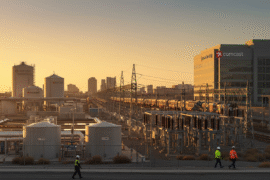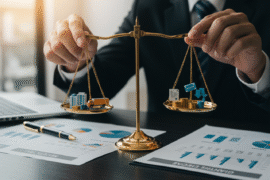This article may contain references to products or services from one or more of our advertisers or partners. We may receive compensation when you click on links to those products or services. Nonetheless, our opinions are our own.
The frequency and severity of climate-related events have created mounting pressure for industries to prepare for environmental disruptions. As global temperatures rise, the vulnerabilities within corporate supply chains, infrastructure, and business continuity plans have become more evident. The timeline for broad-scale private-sector investment in climate adaptation is beginning to take shape.
- Market Pressures Prompting Preparedness
- When Will Spending Increase?
- Barriers Slowing Corporate Action
- Strategic Areas for Adaptation Investment
- Stakeholder Engagement as a Driver of Progress
- Consumer Influence on Corporate Climate Action
- Practical Actions for Business Adaptation Planning
- Conclusion
- FAQs
- Recommended Reads
Market Pressures Prompting Preparedness
Businesses are increasingly exposed to climate variability. From floods and droughts to wildfires and heatwaves, these disruptions have tangible impacts on logistics, operations, and productivity. Several economic and reputational factors are compelling companies to act with greater urgency.
Operational Risk Management
Weather-related events have already disrupted global supply chains, raised insurance premiums, and increased recovery costs. Companies are recognizing the need to harden infrastructure and diversify sourcing to minimize exposure to volatile conditions.
Investor and Regulatory Demands
Financial institutions and asset managers are integrating climate resilience into their risk models. Meanwhile, regulatory bodies are establishing new disclosure frameworks that indirectly pressure firms to invest in adaptation.
Competitive Positioning
Firms are beginning to identify opportunities to lead in the adaptation space. Those that move early may benefit from improved brand reputation, smoother compliance with future regulations, and long-term cost savings.
When Will Spending Increase?
Although timelines vary across sectors, there is a general convergence around the next five years as a window of significant change. Research from McKinsey, CDP, and Deloitte suggests that companies operating in infrastructure-heavy industries will likely escalate adaptation investments. A few factors shaping this trajectory:
- Extreme weather events are becoming more frequent, pushing businesses to respond reactively and, in many cases, proactively.
- Government policy is becoming more prescriptive, particularly in Europe, where adaptation strategies are integrated into climate disclosure standards.
- The insurance industry is recalibrating risk models, making coverage for climate-vulnerable properties more expensive or unavailable, forcing businesses to self-insure through adaptation.
Examples include multinational tech firms investing in data center cooling systems and logistics companies altering hub locations in response to flood risk. These shifts indicate that adaptation spending is no longer hypothetical; it is beginning to appear in capital expenditure plans.
Barriers Slowing Corporate Action

Despite emerging incentives, several obstacles continue to delay widespread investment in adaptation.
Short-Term Business Planning Cycles
Many companies operate under quarterly financial performance frameworks, which can deprioritize initiatives with longer payback periods, even if they are necessary for future resilience.
Uncertainty in Climate Modeling
While predictive tools have improved, uncertainty remains around location-specific climate impacts. This ambiguity can lead to inertia, as businesses hesitate to allocate funds without clear return projections.
Limited Internal Expertise
Adaptation planning often requires input from environmental scientists, engineers, and urban planners.
Strategic Areas for Adaptation Investment
Investment in climate resilience can take many forms. Forward-looking organizations are beginning to reallocate resources toward high-impact interventions.
Infrastructure Reinforcement
Resilient materials, green roofs, permeable surfaces, and energy-efficient HVAC systems are being adopted to manage stormwater, reduce heat absorption, and maintain operations during extreme conditions.
Technology and Forecasting
Investment in advanced analytics and weather monitoring tools helps businesses anticipate risk, plan inventory and logistics, and adjust staffing or delivery models.
Supply Chain Resilience
Firms are expanding sourcing networks and identifying alternate logistics routes to reduce reliance on vulnerable nodes. This not only supports adaptation but also strengthens global competitiveness.
Stakeholder Engagement as a Driver of Progress
Business efforts toward climate adaptation cannot succeed in isolation. Coordination with stakeholders can accelerate planning and ensure that efforts are tailored to regional needs.
Cross-Sector Collaboration
Public-private partnerships are facilitating access to adaptation funding and knowledge-sharing platforms. Shared objectives enable more comprehensive solutions across infrastructure, resource management, and land use.
Internal Communication and Training
Employee engagement in sustainability practices can foster a company-wide culture of awareness and preparedness. Training programs and transparent reporting help align internal stakeholders around adaptation goals.
Consumer Influence on Corporate Climate Action
The growing demand for sustainable products and transparent practices is influencing how companies allocate environmental budgets. Consumers increasingly factor environmental responsibility into purchasing decisions, rewarding brands that take visible action on climate.
Practical Actions for Business Adaptation Planning
For companies beginning to prioritize adaptation, several approaches can be adopted with immediate effect.
Vulnerability Assessments
Risk mapping exercises help identify exposure to natural hazards, evaluate sensitivity across business units, and assess the adaptive capacity of existing systems.
Structured Adaptation Planning
Developing a phased approach allows companies to address short-term vulnerabilities while laying groundwork for long-term infrastructure or policy changes.
Internal Capacity Building
Embedding climate resilience into corporate governance structures and recruiting specialists where necessary ensures continuity and accountability.
Conclusion
Corporate spending on climate adaptation is gaining momentum, shaped by regulatory trends, economic imperatives, and environmental urgency. While uncertainty and short-term pressures still slow progress in many industries, the trajectory is becoming clearer: businesses will be expected to invest in resilient systems. The companies that act now position themselves not only to withstand future disruptions but also to lead in a shifting economic and environmental landscape.
FAQs
Why are businesses starting to invest more in climate adaptation?
Businesses are experiencing operational risks from extreme weather, regulatory pressure for climate disclosures, rising insurance costs, and shifting investor expectations. These pressures are encouraging proactive investment in infrastructure and planning for long-term resilience.
Floods, wildfires, droughts, and heatwaves are among the most disruptive. These events damage physical assets, interrupt supply chains, and lower productivity, prompting businesses to reassess risk exposure.
How does climate change impact supply chains and logistics?
Extreme weather can delay shipments, damage transportation infrastructure, and disrupt sourcing from climate-vulnerable regions. To manage this, firms are diversifying suppliers and reevaluating warehouse and distribution hub locations.
Which industries are most likely to increase adaptation spending?
Industries with heavy infrastructure needs, such as energy, transportation, agriculture, and technology, are expected to lead the shift toward climate resilience in the next five years.
What role do investors and regulators play?
Investors are embedding climate risk into portfolio decisions, while regulators, especially in Europe, are requiring disclosure of adaptation efforts. Both forces incentivize companies to act early or risk falling behind.

Reviewed and edited by Albert Fang.
See a typo or want to suggest an edit/revision to the content? Use the comment form below for feedback.
At FangWallet, we value editorial integrity and open collaboration in curating quality content for readers to enjoy. Much appreciated for the assist.
Did you like our article and find it insightful? We encourage sharing the article link with family and friends to benefit as well - better yet, sharing on social media. Thank you for the support! 🍉
Article Title: When Will Companies Start Spending on Climate Adaptation?
https://fangwallet.com/2025/06/25/when-will-companies-start-spending-on-climate-adaptation/The FangWallet Promise
FangWallet is an editorially independent resource - founded on breaking down challenging financial concepts for anyone to understand since 2014. While we adhere to editorial integrity, note that this post may contain references to products from our partners.
The FangWallet promise is always to have your best interest in mind and be transparent and honest about the financial picture.
Become an Insider

Subscribe to get a free daily budget planner printable to help get your money on track!
Make passive money the right way. No spam.
Editorial Disclaimer: The editorial content on this page is not provided by any of the companies mentioned. The opinions expressed here are the author's alone.
The content of this website is for informational purposes only and does not represent investment advice, or an offer or solicitation to buy or sell any security, investment, or product. Investors are encouraged to do their own due diligence, and, if necessary, consult professional advising before making any investment decisions. Investing involves a high degree of risk, and financial losses may occur including the potential loss of principal.
Source Citation References:
+ Inspo
There are no additional citations or references to note for this article at this time.












































